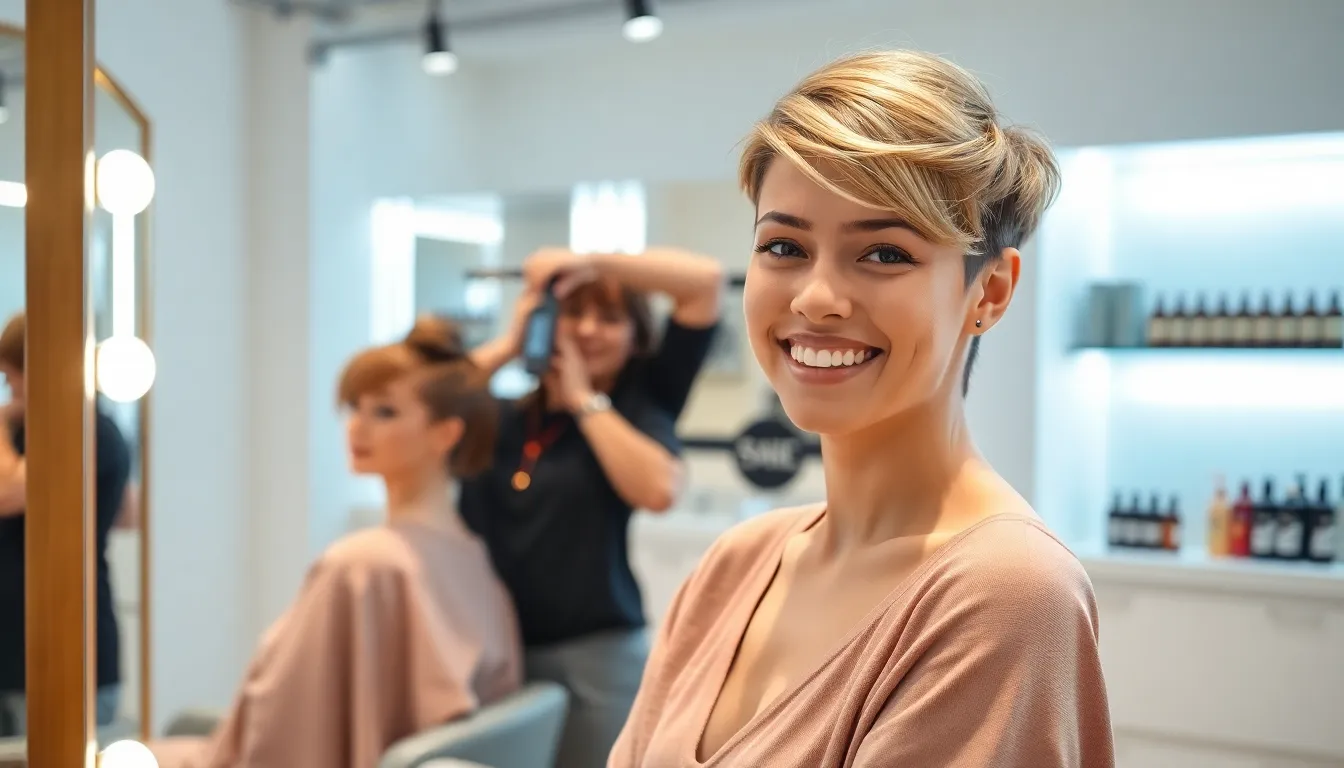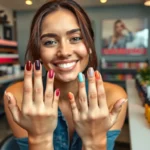We’ve all been there – staring in the mirror and wishing our hair looked fuller and more voluminous. If you’re dealing with thinner hair, you’re not alone, and we’ve got incredible news: the right short haircut can completely transform your look and make your hair appear dramatically thicker.
Short hairstyles aren’t just trendy – they’re game-changers for women with fine or thinning hair. When you cut away excess length, you’re eliminating weight that pulls your hair down and creates that flat, lifeless appearance we all want to avoid. Instead, you’ll discover how strategic cuts can create the illusion of density and body you’ve been craving.
We’re about to share the most flattering short haircuts specifically designed for thinner hair, along with styling secrets that’ll have everyone asking about your amazing new look. These cuts don’t just work – they’ll revolutionize how you feel about your hair every single day.
Pixie Cuts That Add Volume and Texture
Pixie cuts offer incredible versatility for transforming thin hair into a voluminous, textured masterpiece. These strategic styles work by creating movement and dimension that makes your hair appear fuller than it actually is.
Classic Textured Pixie
Classic textured pixies create stunning dimension through carefully placed layers throughout the crown and sides. We recommend asking your stylist to add choppy, uneven layers that break up the hair’s natural fall pattern. This technique prevents your thin strands from lying flat against your scalp.
Styling becomes effortless when you work texturizing paste through damp hair and scrunch gently while blow drying. The irregular lengths catch light differently, creating the illusion of thicker, more abundant hair. Point cutting techniques during your salon visit will enhance this natural texture even further.
Asymmetrical Pixie with Side-Swept Bangs
Asymmetrical pixies featuring longer sections on one side instantly add visual weight to thin hair. We love how the uneven lengths create natural volume by preventing hair from settling into predictable patterns. Side swept bangs frame your face beautifully while adding crucial density around your hairline.
Longer pieces on one side can be styled forward or tucked behind your ear for versatility. The contrast between shorter and longer sections makes your overall hair appear more substantial. Professional stylists often recommend keeping the longer side about 2-3 inches longer than the shorter side for optimal balance.
Choppy Layered Pixie
Choppy layered pixies maximize texture through strategic disconnected layers cut at various lengths. We’ve found these cuts work exceptionally well for fine hair because each layer creates its own movement and body. The jagged, piece-y effect prevents thin strands from clumping together.
Layers should start at different points around your head rather than following traditional graduated patterns. This randomness creates natural separation and prevents your hair from looking too uniform or flat. Finish with a lightweight mousse applied to roots for extra lift and hold throughout the day.
Bob Haircuts That Create Fullness

Bob haircuts rank among our top recommendations for women with thinner hair because they create the illusion of fullness through strategic cutting techniques.
Blunt Bob for Maximum Density
Blunt bobs deliver maximum visual density through their straight, even finish across the ends. Cut to chin or jaw length, this style benefits thinner hair by providing a heavier weightline that visually increases structure and thickness. The blunt cutting technique reduces splits and flyaways, making hair appear fuller and healthier overall.
We love this classic option because it’s incredibly low maintenance while offering a modern yet simple aesthetic. The even hemline creates a solid foundation that prevents thin hair from looking wispy or damaged at the ends.
Layered Bob with Face-Framing Pieces
Layered bobs incorporate subtle layers that begin mid-shaft and extend to the ends, providing movement and body to fine hair. Face-framing layers draw attention to your cheekbones and jawline while preventing the overall style from appearing flat against your head.
This technique allows for volume at both the roots and ends, creating a textured, voluminous appearance that thin hair desperately needs. Styling becomes even more effective when you add dry shampoo or texturizing products at the roots for extra lift and separation.
Inverted Bob with Graduated Layers
Inverted bobs feature shorter lengths at the nape that gradually lengthen toward the front, creating natural dimension. Graduated layers in this style produce a natural lift at the back, making your hair look noticeably thicker and more substantial.
The angled lines and stacked layers add movement and dimension that’s particularly effective for thin hair seeking extra bounce. We recommend this style for its modern edge and versatility in daily styling, as the graduated layers maintain their shape even between salon visits.
Lob Styles That Enhance Thin Hair

Lobs offer the perfect middle ground between short and medium lengths, falling gracefully between the chin and shoulders to create stunning volume for thinner hair. These versatile cuts combine the benefits of shorter styles with added length flexibility.
Wavy Lob with Subtle Layers
Wavy lobs with subtle layers introduce essential texture and movement that makes fine hair appear significantly fuller. Light face-framing layers enhance volume without creating the stringy appearance that overdone layering can cause. We recommend keeping layers minimal and strategic, focusing on gentle graduation rather than dramatic cuts. Styling involves scrunching damp hair with texturizing mousse and air-drying for natural-looking waves. This approach creates the illusion of density while maintaining the hair’s natural body and preventing flatness at the roots.
Straight Lob with Blunt Ends
Straight lobs with blunt ends deliver a sleek, modern aesthetic while maximizing the appearance of thickness. Blunt cuts create a solid line at the ends that visually increases density and provides a fuller finish. This low-maintenance style requires minimal daily styling, making it ideal for busy women seeking effortless elegance. We suggest using a flat iron for pin-straight results or simply blow-drying with a paddle brush for smooth, polished ends. The geometric precision of blunt lobs prevents split ends and flyaways that can make thin hair look sparse.
Tousled Lob with Beach Waves
Tousled lobs with beach waves maximize texture through loose, undone waves that enhance natural movement. This effortless style increases volume perception by creating intentional dishevelment that appears naturally full. Light layering paired with the tousled effect adds substantial fullness while maintaining a carefree, lived-in appearance. Achieve this look using sea salt spray on damp hair, scrunching while blow-drying with a diffuser attachment. The combination of waves and subtle texture makes thin hair appear more voluminous and ever-changing than structured styles.
Shag Cuts That Boost Hair Volume

Shag cuts offer exceptional versatility for adding volume and texture to thinner hair. These styles create natural movement through strategically placed layers that enhance fullness without overwhelming fine strands.
Modern Shag with Curtain Bangs
Modern shag haircuts with curtain bangs create stunning face framing effects while adding essential texture to thin hair. Curtain bangs sweep gracefully to both sides of the face, creating visual weight around the forehead area that balances the overall silhouette. Layers throughout the crown and mid lengths work together to lift hair away from the scalp, preventing the flat appearance that often plagues thinner hair types.
We recommend styling this cut with a round brush while blow drying to enhance the natural lift at the roots. Texturizing spray applied to damp hair adds grip and hold, making fine strands appear thicker and more substantial. The curtain bangs require minimal maintenance compared to blunt fringe styles, growing out seamlessly as they follow the natural hair growth pattern.
Layered Shag with Feathered Ends
Layered shag cuts with feathered ends make hair feel light and airy while adding natural bounce to thin strands. Feathered layers create soft, wispy edges that move beautifully with natural head movement, eliminating the heavy, weighed down look that can occur with blunt cuts. These layers start around the cheekbone area and continue through the ends, building volume progressively from mid length to tips.
Styling this cut involves scrunching damp hair with mousse to enhance the feathered texture while air drying. We suggest using a diffuser attachment on low heat to maintain the natural movement without creating frizz. The feathered ends require regular trims every 6 to 8 weeks to maintain their shape and prevent splitting that can make thin hair appear even more sparse.
Short Shag with Wispy Texture
Short shag cuts with wispy texture provide versatile and adaptable styling options that work exceptionally well for fine hair. Wispy layers create separation between hair strands, preventing them from clumping together and appearing flat against the head. These textured pieces add dimension throughout the cut, with shorter layers at the crown creating lift and longer pieces around the perimeter maintaining feminine softness.
We find this style works best when enhanced with sea salt spray applied to towel dried hair for natural texture. Finger styling while the hair air dries creates the perfect tousled effect that makes thin hair appear fuller and more voluminous. The wispy texture adapts easily to different styling preferences, looking equally polished when smoothed with serum or deliberately messy when scrunched with texturizing cream.
Styling Techniques to Maximize Volume

Now that we’ve covered the best short haircuts for thinner hair, let’s explore the essential styling techniques that’ll make your short hair look dramatically fuller and more voluminous.
Root Lifting Methods
Root lifting sprays create instant volume without adding unwanted stiffness to your delicate strands. We recommend applying Color Wow Raise the Root or Redken Root Lift Spray directly to your roots before styling for maximum lift and body. Professional stylists consistently choose these products because they deliver noticeable results without weighing down fine hair.
Sectioning your hair while applying root lift products ensures even distribution and optimal results. We suggest working in small sections and focusing the spray placement at the base of each strand. This targeted approach creates natural looking lift that lasts throughout the day.
Texturizing Product Applications
Texturizing sprays transform limp hair into textured locks with incredible grip and movement. We apply these products with a light hand to add essential grit without creating buildup that flattens your style. Dry shampoos work similarly by absorbing excess oils while adding valuable texture that enhances volume.
Strategic application matters more than product quantity when working with texturizing formulas. We recommend focusing on mid lengths and ends rather than saturating your roots. This technique prevents your hair from appearing greasy while maximizing the volumizing benefits.
Blow-Drying Techniques for Lift
Round brush blow drying creates professional level volume by lifting hair directly from the roots. We wrap small sections around a medium barrel brush and direct the airflow upward to achieve maximum lift. This classic technique works especially well on short cuts because there’s less weight pulling your hair down.
Upside down drying delivers dramatic root lift that traditional methods can’t match. We flip our heads forward and blast warm air at the roots while scrunching gently with our fingers. Heat styling tools become even more effective when you blow dry your hair in the opposite direction of your natural part for added lift and dimension.
Professional Tips for Maintaining Short Cuts

Professional maintenance makes all the difference in keeping your short haircut looking its absolute best. We’ve compiled expert-approved strategies that’ll help you preserve your style’s shape, volume, and overall health.
Regular Trim Schedules
Every 4-6 weeks is the golden standard for maintaining short cuts on thinner hair. Shorter styles grow out faster and lose their shape more quickly than longer styles, making consistent trims essential for preserving the intended silhouette.
Split ends become more noticeable on thin hair because there’s less volume to camouflage damage. Regular trims prevent these splits from traveling up the hair shaft, which can make already thin strands appear even more sparse and unhealthy.
Professional stylists recommend booking your next appointment before leaving the salon. This proactive approach ensures you maintain the optimal shape and prevents that awkward “in-between” phase that can make thin hair look lifeless.
Seasonal adjustments help accommodate natural hair growth patterns. Your stylist can make subtle modifications during each visit to account for how your hair responds to different weather conditions and styling routines.
Color Techniques That Add Dimension
Strategic highlighting creates the illusion of depth and thickness in thin hair. Subtle highlights placed throughout your short cut add dimension that makes individual strands appear more substantial and voluminous.
Balayage techniques work exceptionally well on short styles because the hand-painted highlights follow your hair’s natural movement patterns. This creates organic-looking dimension that enhances your cut’s texture without overwhelming thin strands with too much contrast.
Lowlights paired with highlights create a multi-dimensional effect that maximizes visual density. The interplay between lighter and darker tones tricks the eye into perceiving more hair than actually exists, making your short cut appear fuller and more ever-changing.
Root shadowing adds depth at the crown while keeping ends lighter, creating natural-looking dimension that grows out gracefully. This technique reduces maintenance requirements while providing the thickness-improving benefits of professional color work.
At-Home Maintenance Routines
Volumizing products become your daily essentials for maintaining fullness between salon visits. Apply root-lifting sprays to damp hair before blow drying, focusing on the crown area where thin hair tends to lie flat against the scalp.
Round brush blow drying creates lasting lift and body in short cuts. Work in small sections, lifting hair at the roots while directing airflow from roots to ends to seal the hair cuticle and enhance shine.
Dry shampoo serves double duty as both a cleansing agent and volume booster. Apply it to clean, dry hair on non-wash days to absorb excess oils while adding texture and grip that makes styling easier.
Texturizing products like sea salt sprays or lightweight mousses enhance your cut’s natural movement without weighing down thin strands. Apply these products sparingly to avoid buildup that can make hair appear greasy or limp.
Sleep protection maintains your style’s integrity overnight. Use a silk or satin pillowcase to reduce friction that can flatten carefully styled volume, and consider a light misting of texturizing spray before bed to preserve your cut’s shape.
Conclusion
Finding the perfect short haircut for thinner hair doesn’t have to be overwhelming. We’ve shown you that with the right cut and styling techniques you can achieve incredible volume and fullness that transforms your entire look.
Remember that consistency is key – regular trims and proper maintenance will keep your short style looking fresh and voluminous. Don’t be afraid to experiment with different textures and styling products to find what works best for your hair type.
The most important thing we want you to take away is that thinner hair isn’t a limitation – it’s simply an opportunity to discover amazing short styles that enhance your natural beauty and boost your confidence every single day.
Frequently Asked Questions
What are the best short haircuts for thin hair?
The most flattering short haircuts for thin hair include pixie cuts, bob styles, lobs (long bobs), and modern shag cuts. These styles work by removing excess weight that can make thin hair appear flat while incorporating strategic layers and textures that create the illusion of fuller, more voluminous hair.
How often should I trim my short haircut to maintain its shape?
You should trim your short haircut every 4-6 weeks to maintain its shape and prevent split ends. Regular trims are essential for keeping short styles looking fresh and preventing an awkward “in-between” growth phase. Consider booking your next appointment before leaving the salon.
What styling products work best for adding volume to thin, short hair?
Root lifting sprays like Color Wow Raise the Root or Redken Root Lift Spray are excellent for creating instant volume. Texturizing sprays and dry shampoos also add grip and movement to thin hair. Apply products strategically in sections for even distribution and avoid overuse to prevent greasiness.
Can I achieve volume with short hair using blow-drying techniques?
Yes, proper blow-drying techniques can dramatically increase volume in short hair. Use a round brush to lift hair at the roots while drying, or try the upside-down drying method for maximum root lift. These techniques are particularly effective for short hairstyles and create lasting volume.
Do color techniques help make thin hair look fuller?
Strategic highlighting and balayage techniques can add significant dimension and the appearance of fullness to thin hair. These color methods create depth and visual interest that makes hair appear thicker and more substantial while enhancing the overall style of your short haircut.
What’s the difference between a pixie cut and a bob for thin hair?
Pixie cuts are shorter and offer maximum volume by removing weight, while bobs provide more length with strategic layering. Pixie cuts are ideal for those wanting dramatic volume and low maintenance, while bobs offer versatility and can create the illusion of thickness through blunt or layered cutting techniques.
How can I maintain my short haircut’s volume between salon visits?
Use volumizing products daily, blow dry with a round brush lifting at the roots, and apply dry shampoo and texturizing sprays as needed. Protect your style while sleeping with silk pillowcases or loose hair wraps to maintain volume and prevent flattening overnight.















